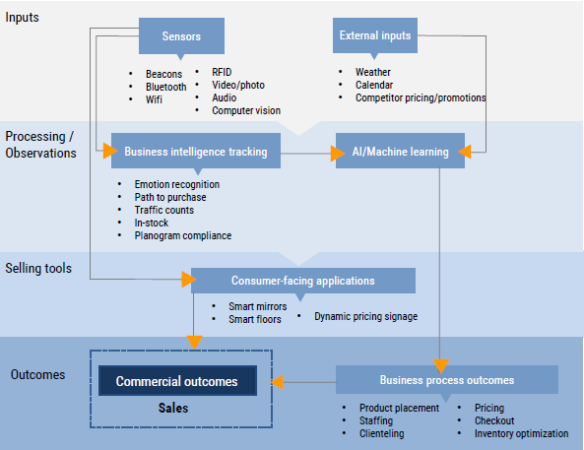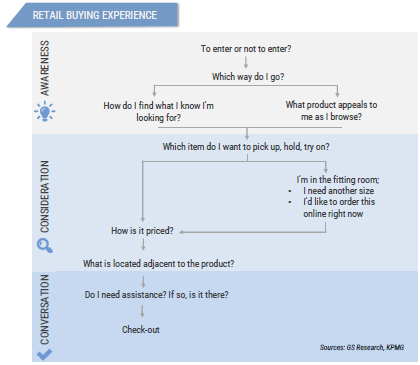We live in the epoch of E-Commerce, and we are so used to it that even don’t notice how it has become an integral part of our everyday life. We make online payments because it’s cheaper, simpler, and doesn’t require even going out or leaving the favorite armchair.Education, clothes, presents for Christmas, cosmetics, techniques, products, this list goes on the on. From the first view, it seems evident that one day in the future online stores will completely displace physical stores. Well, you will be shocked because statistic states that for today 85{3fbfd6f1e6b19884051837dbbbebf333964dd5fac151615ffbd47b80e5ecc87a} of all the retail sales are transacted in stores. Why is it happening and how will the shop of the future look? Let’s check.
Machine learning and bread buying – related concepts?
So, taking into account the statistical data that only 15{3fbfd6f1e6b19884051837dbbbebf333964dd5fac151615ffbd47b80e5ecc87a} of all the purchases are made online, the decision for retailers is predictable – leave the store. But it will not be enough, all the retailers today have faced with the real challenge – to enhance the showroom instead of replacing it. Improvement and innovations usually go hand-in-hand, so the wisest way to keep running the business is to implement the state-of-art technologies that will allow filling the information gap between the online stores and marketplace. To do this, retailers combine IOT and machine learning and evaluate lots of factors to sort out the sensitivity of buyers to changes in the price tags and the popularity of one or another product. All the tools used for improving the business have one goal in common – to engage young generation and motivate them to make purchases.
To avoid bankruptcy and to put their business on the next level, many modern firms have started “to mimic” the main mechanisms of the e-commerce. They offer customers to order online or to pick up their ordered purchases in stores. It is the first reaction and probably the simplest way to improve the store and to keep doing a prosperous business. There are some other methods to do this more “modern” and thoughtfully, we will discuss them a bit later.
Aliens among us. How will the retailer of the future look?
So, we have more or less sorted out how will the store of the future look like and will it exist at all. Now it’s time to consider no less important player of this game – a retailer. Will he look like a strange green creature or maybe he will be replaced with the high-end machine able to perform all the necessary functions? Taking into account the fact that the stores in the closest future will be similar to existing ones but with the new technologies implemented, it’s pretty evident that the retailers in them will also be like the ones we have today. But! Because of the improvement and development of the store, a retailer should also be “improved.” Most likely, the retailer of the future will be more efficient. To get success in the business, he will have to act either as:
- ultra-convenient shopping option;
- perfectly optimized logistics machine;
- the improved showroom.
The best examples to consider and follow the mechanisms of work are such monsters of the trading world as Walmart and Amazon. For today, due to the convenient and organized delivery, they provide the most comfortable shopping experience. The major challenge for retailers will be to move their supply chains toward these highly-efficient models.
Another important task for the retailer of the future will be to improve and maximally tighten relationships with the customers. It can be performed through high-quality data, various memberships, and evaluated through analytics.
How to enable the store of the future?
Some years ago and even today for lots of people the concept of “store of the future” has laid in something similar to the usual store but brighter, shinier, and newer. Not so many people have thought about the economics mechanisms or complex business processes that lay in the basis. The main parameter has been aesthetic, and many of the stores were larger and brighter but not necessarily better. Visual was more important than economic. Have the things changed? Definitely yes. To date, the main basis for “store of the future” lays in ideally thought out economic mechanisms, business concepts, and marketing strategies. Let’s consider three main application for enabling the store of the future and sort out why they are its integral part.
- Application one – data. All of the retailers (we are talking about the ones aimed at the prosperous trade) need data. It should be taken as an axiom. They need to know the shopping history of a customer, his preferences, shopping experience, gender, and age. In addition to this, retailers need to ideally understand any of the changes in goods placement and its availability on stocks. Moreover, they should carefully analyze how do the changes in price tags influence the customer’s behavior and their willingness to order commodities. The more data, the better the result – this is the first rule.
- Application two – marketing. To encourage customers to purchase one or another commodity, retailers should use the method of highlighting the product with visual clues and information. They need to change the prices according to the data collected after an analysis of the customers’ behavior. Also, the interface of the store is essential. Customers should be able to capture more information than with the smartphone by visiting the online store website. Applications created for the business intelligence can be used in a way beneficial both for customer and retailer, by providing data that is important for both sides. For example, it can be info about the availability of the commodity in stock or its location in the store.
- Application three – cost. For deployment of the business intelligence tools, retailers can optimize expenses, for example, wage.
For the correct use of these applications and getting the desired result, retailers should also understand the specifics of the market they work in. For example, in the case of mass-market, when a large number of low-cost commodities are selling, the most critical parameters are goods visibility and customer habits. The different situation is for high-value transactions when the high-value products are selling. In this case, the most valuable is driving transactions reached through the in-store marketing.
Smarter!
Smart homes, smartphones, smart…everything, we live in the “smart” epoch, and it will not become a surprise that smart technologies are an integral part of the store of the future. Retailers all over the globe try to keep up with the times and improve their stores by the marriage of IOT and machine learning and implementation them into the regular shopping. Yes, you may say that it has been used for years already, cameras have monitored the stores, and RFID technology was used for inventory tracking. It is correct, but the state-of-art technologies allow retailers to get more custom-designed analytics resulting in the more advanced deployment. The new solutions enable retailers to strengthen both their marketing goals and business intelligence. Among these technologies are:
- Sensors. Modern sensors can track activity through the photo-, video-, or wireless signals and pass this info for processing easily and quickly. Also, the devices can post new prices or marketing messages.
- Artificial intelligence. Through AI (which is also enhanced by machine learning) it is possible to interpret observations and deduce and analyze their consequences.
- All the computing performed is enabled by the cloud.
So, what are “the smartest” tools for shopping nowadays? We have collected the key to them:
- Smart Shelves. These shelves monitor the integrity of goods and provide the real-time feedback to the associate in case if the problem occurred.
- Audio analytics. The primary goal of these devices is to evaluate the level of traffic in the store.
- Smart floors. The floors also monitor the traffic and analyze the customers’ behavior.
- Video analytics. These devices allow classifying the consumers by their age, gender, demographic groups. Then they track and analyze their behavior with the help of the emotion recognition software.
- Staffing software. The soft tracks and analyzes a number of customers, the frequency of their visits, and dwell time. Then it uses this data against staffing insights for optimization of labor scheduling.
- Smart dressing rooms (mirrors). Here the RFID technology is used that identifies the item that has been brought into the dressing room. It helps the retailer to evaluate which of the goods are in higher demand and are hence close to purchasing. It enables interaction with a buyer on the verge of a deal.
Innovation and implementation. Is there a gap between them?
Innovation and development of e-commerce technologies have all the chances to replace the physical stores one day. Also, the rapid decline in sales can immediately undermine the retailers’ economics, making the idea of the investment quite controversial. In addition to this, there is a probability that retailers will decide to focus on their online stores because the cost of new tools is high while investing in them may be risky. At the same time, waiting until the cost curves will fall may result in fading the resources faster than the cost drops.
Probably, these are the main “barriers” to implement the new technologies and improve the routine way of shopping to the innovation level.



Recent Comments